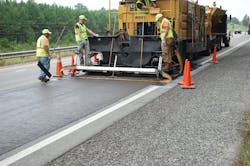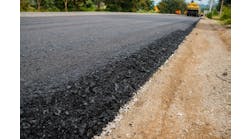By Adriana Vargas-Nordcbeck, Contributing Author
Pavements are one of the most valuable assets for any agency. They deteriorate over time and can lose their value if not properly maintained. It has been known that pavement preservation activities can help extend the life of a pavement; however, the information has been mostly anecdotal.
The lack of data has pushed some agencies away from developing a preservation program for fear of placing a treatment that will not perform well under their conditions.
To fill this knowledge gap, the National Center for Asphalt Technology (NCAT) at Auburn University began a pooled fund study in 2012 aimed at quantifying the life-extending benefit of various types of pavement preservation treatments.
The initial effort was supported by seven state Departments of Transportation (DOTs) and industry leaders, who provided funding for the research. Full-scale test sections were built on a low-traffic volume county road in Auburn, Ala., minutes from the NCAT main office.
Twenty-three treatments were applied, including crack sealing, chip seals, scrub seals, micro surfacing, cape seals, and thin overlays. Untreated sections were also left in place for comparison.
The project required careful planning to overcome the challenging logistics of placing numerous treatments on an open roadway. The collaboration from stakeholders was crucial for the successful completion of the construction stage.
Following construction, the test sections’ performance was monitored for the next three years in conjunction with NCAT’s fifth research cycle. The results quickly drew attention from other DOTs, gathering support to continue the research and expand the scope of work.
NCAT established a partnership with the Minnesota DOT’s Road Research Facility (MnROAD), which resulted in more states joining the pooled fund and the construction of new test sections.
In 2015, treatments were placed along U.S. Highway 280 near Opelika, Ala. This location captured higher traffic volume to determine its effect on treatment performance. The experimental design was an extended version of the original project, adding more treatment variations and combinations. This was followed by the construction of a test section in Minnesota in 2016.
Similar types of roadways were selected (a county road and a stretch of U.S. Highway 169 near Pease, Minn.) to capture the effect of cold climate on the service life and benefit of the treatments.
Over 20 state DOTs, the Federal Highway Administration (FHWA), and industry supported the continuation of this effort.
Overall, 145 test sections – including control sections – are part of this research project. With a few exceptions, the treatments have remained in place for as much as 12 years without the need for additional work.
Pavement performance is monitored periodically to quantify surface distresses, roughness, friction, and structural condition. The results from the treated sections are compared to the untreated sections to determine the life-extending benefit of the treatments, a key input to help agencies make justifiable, data-driven decisions.
An important part of the analysis consisted of accounting for the existing condition of the pavement at the time of treatment.
Proper treatment selection is essential for the success of pavement preservation, and optimal timing is necessary to obtain the greatest benefit. Results from this research show that treating pavements while in good to fair conditions yields the most benefit.
However, this is not always a popular approach as the driving public may perceive this as resources being allocated where they are not needed.
A successful preservation program must be accompanied by a strong outreach effort to educate taxpayers, elected officials, and even technical personnel within the agency to obtain buy-in from all parties. Research like the one conducted by NCAT and MnROAD provides technical information that can help agencies seek support for pavement preservation.
Another outcome of the research was the differences observed due to climate. The deterioration mechanism of the pavements is different depending on the environmental conditions, and treatment effectiveness can vary significantly.
However, adjustments can be made to improve the chances of success.
Chip seals are a cost-effective alternative in warm climates, sealing the pavement surface, correcting minor distresses, and improving skid resistance. However, in cold regions the service life of the treatment was reduced due to snow plowing operations removing some of the cover aggregate.
While a single-layer chip seal may not be able to withstand such external forces, other variations such as multi-layer chip seals, scrub seals, and fiber membrane reinforcement have performed satisfactorily.
The main question in this research project is not which is the best preservation treatment, but rather what the expected performance of a particular preservation treatment is given the local conditions.
No treatment can be considered “the best,” as they all target different issues. However, the development of performance models to predict life expectancy is a powerful tool that can be used in combination with cost information to determine the most cost-effective option for an agency.
The NCAT-MnROAD partnership has worked for years to put the outcomes of this research in the hands of agency personnel in charge of managing pavement networks. Multiple journal articles, webinars, and an online tool with performance data are available to the public.
Phase Two of this long-term research study concluded in December 2023 but the effort is far from over. A new pooled fund begins in 2024 for a third phase focused on implementation and improving the quality of pavement preservation treatment construction.
The existing test sections will continue to be monitored and analyzed to improve the deterioration models developed under the previous phases.
In addition, NCAT and the National Center for Pavement Preservation (NCPP) will assist participating agencies in the construction of new test sections within their states. The two centers will provide technical assistance during planning and construction through specification review, preconstruction meetings, training, and inspection. The agencies will share performance data to be analyzed using the same approaches developed by NCAT during phases One and Two.
A strong outreach component is part of this new phase to help in the dissemination of research findings.
Journal articles, webinars, meetings, and the development of enhanced tools will continue to be part of the research.
Each participating agency will provide a representative to serve on the Technical Assistance Panel (TAP) to help guide the research. To date, 16 agencies have committed funding for this project, with an additional five to six agencies expected to join. Industry leaders and FHWA will continue to provide assistance through supporting roles.
Pavement preservation is a proven strategy that can help extend pavement life.
Research like the one conducted by NCAT and its partners has provided valuable information for over a decade and is expected to continue helping agencies make better use of their resources to manage their pavement networks more efficiently. RB
Adriana Vargas-Nordcbeck, Ph.D., is an associate research professor at the National Center for Asphalt Technology at Auburn University.


